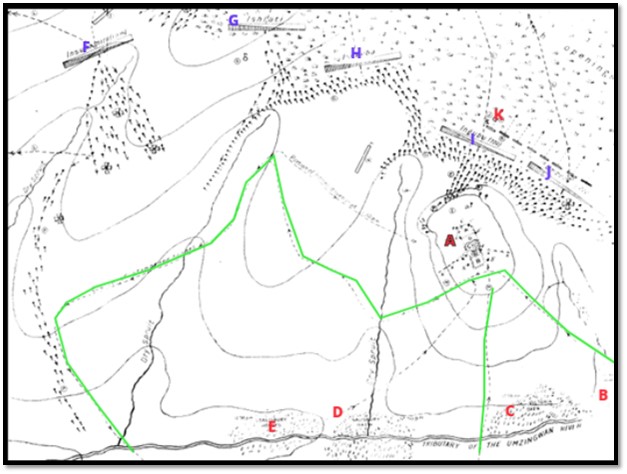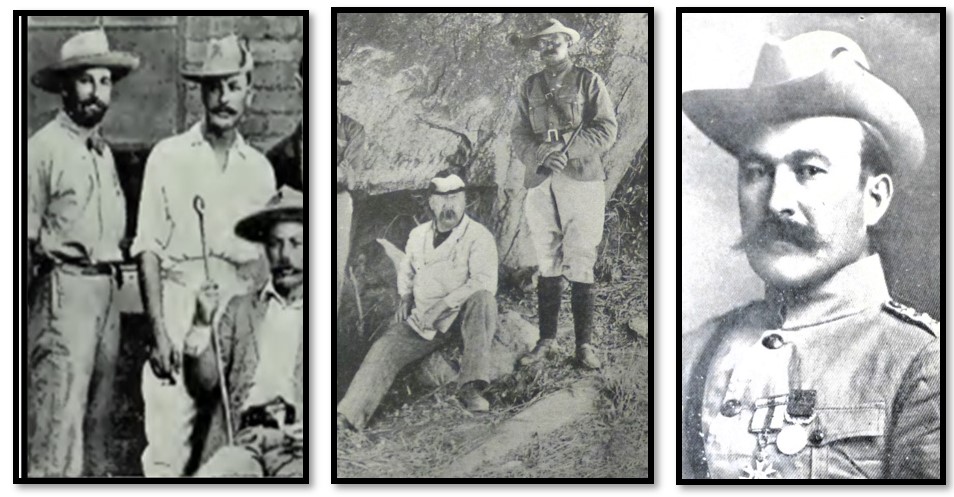A veteran’s account from the Battle of Bembesi in 1893 and when Joe Smith knocked down Cecil Rhodes and saved his life in 1896
Much of the material included in this article is taken from a presentation copy of Occupation of Matabeleland: A Souvenir that was prepared by The Fortieth Anniversary Celebration Committee. There were celebrations in November 1933, forty years after the occupation of Matabeleland.
This was written by J. Squair whose portrait appears in the article Veterans of the 1893 occupation of Matabeleland and is mostly taken verbatim from the original article with a few edits. He begins by saying that the most vivid of his memories of the early days are the stampede of the horses at the Battle of Bembesi in 1893 and the occasion when Trooper Joe Smith saved the life of Cecil Rhodes.
The horse stampede at the Battle of Bembesi (called Egodade by the amaNdebele) on 1 November 1893
Even today, after forty years, I thrill when I recall the stampede of horses at the Battle of Bembesi. It was a wonderful sight. The Column had gone into laager.[1] The horses were out to graze, pickets having been posted, when the natives suddenly appeared out of the bush from the north. And they came in large numbers, opening a fierce fire on the laager. The pickets were lucky in escaping with their lives.[2] The guards drove the horses into laager but had no time to tie them up (there would have been about 230 horses) as they had to hurry off to their places on the wagons in the firing line. The firing increased in intensity and bullets were singing over our heads like a swarm of bees. It was more than the horses could be expected to endure and they wheeled and charged out of the laager, their manes and tails tossing in the wind. Down the hill they galloped straight for the enemy's lines. It was a grand sight to watch, but as we saw them gallop away, we felt that our last hope had gone. I can still picture that mad stampede.

Adapted from Sir John Willoughby’s Plan IV in The Downfall of Lobengula
KEY
A Salisbury and Victoria Columns laager
B Victoria Column horses that bolted along a route shown by the green line
C Victoria oxen
D Salisbury oxen
E Salisbury horses
F Insukameni Regiment
G Ihlati Regiment
H Isezeba (Siseba) Regiment
I Ingubu Regiment
J Umbeza Regiment
K Pickets White and Thompson
I was one of the crew of the Nordenfelt quick-firing machine guns, which were always posted in front of the laager. Our position was just alongside the wagon of Dr Jameson, Major Forbes and the staff. The staff also had a Maxim commanded by Lieut Tyndale-Biscoe. The stampeding of the horses threw our guns out of action as the horses were directly in the line of our fire. Thus we became spectators. I was quite close to Dr Jameson and the members of the staff. They all turned pale. It seemed that all was lost. There were some horses tied up in laager in case of emergencies and it was suggested that someone should use them in pursuing the stampeding animals and bringing them back. But what a task!
Sir John Willoughby and Trooper Webb volunteered, and their horses were saddled. Meantime, Lieut Tyndale-Biscoe’s Maxim was turned round towards the side of the horses which by this time were galloping straight to the enemy's lines. Never have I seen a Maxim gun handled as Lieut Tyndale-Biscoe handled his that day.[3] He sprayed the ground, raising the dust between the horses and the enemy, raising his elevation as the horses drew further and further away. He did not waste shots either, just firing a few shots, then raising the elevation and firing a few more.[4] You would not have believed that a Maxim would have carried so far.
After about a mile the horses were headed off and Lieut Tyndale-Bisco managed to change their direction away from the enemy's lines. He must have felt a thrill even greater then when he hoisted the Flag in Salisbury in 1890 when he saw the success of his efforts. Everybody cheered. Meanwhile, Sir John Willoughby and Trooper Webb had mounted. They went hell for leather down the hill after the horses. The hill was strewn with loose stones and any minute we expected to see the riders thrown. Some of the natives saw what the riders were after and they took potshots at them. Some natives ran towards the riders, and sitting down, fired at them. But luck favoured the riders. They managed to get ahead of the horses and turn them towards the left, heading them back towards the laager. Never did cowboys ride so hard or take so many risks! Sir John Willoughby and Trooper Webb were real heroes.
After the horses were headed off, the enemy’s fire slackened and our gun was able to come into action again. The seven-pounder also got to work. The pom-pom of the Victoria Column, the Gardner gun now on the monument (at Masvingo) was in action all the time. One of the crew was shot. This gun did more than its share in repulsing the enemy, who now began to retire beaten. A foot detachment of the Victoria Column followed and cleared the bush.
When Rhodes was knocked down by Trooper Joe Smith on the Umgusa river in 1896
By June 1896 General Carrington had taken over the command of the Matabele Field Force (MFF) and three expeditions were formed to crush the Matabele. One under Lieut-Col Plumer, the second under Capt A. Macfarlane and the third under Capt John Spreckley. Colonel Plumer’s Column was to go to the junction of the Gwaai and Umguza rivers. Capt Macfarlane was to go in support, while Colonel Spreckley was given the bigger task of attacking the Matabele, who were concentrated on the Upper Umguza river.

(L) Capt A. Macfarlane Gen Sir F. Carrington and Lt-Col Herbert Plumer Capt John Spreckley
Rhodes who was at Government House, intended to go with Spreckley’s Column, but Macfarlane got away first and was almost out of sight when Rhodes came out. It appears he had been waiting at Government House for Spreckley’s Column which was not to be ready for several hours. In the interval, however, a lady called to see Rhodes. However, he did not want to see her and when she passed his window he decided to beat a strategic retreat and got out by the back door and quickly mounted a horse and followed Captain Macfarlane's column. His secretary engaged the lady in conversation until Rhodes had got well underway. Eventually, she demanded to see Rhodes and the obliging secretary took her outside and pointed to the horseman away in the distance.
Rhodes overtook the column in the afternoon. In two days we had reached Nyamandhlovu where we halted in open flat ground. There we went into laager with thornbushes for protection. We had two Maxims mounted on carriages and one seven-pounder field gun. So far as we could see, there were no natives in the vicinity and we remained four days awaiting the arrival of wagons with supplies. Field sports were held and Rhodes provided the prizes. Every man in the column received a good tot of brandy from Rhodes’ own store. Later we realised that the natives were watching us under cover of thick bush. They were waiting to intercept Plumer on his way back from the Gwaai river, but they made no attack on us. Scouts were sent out to guide Plumer to where we were in laager.
Later, however, it was decided that we should press on and join up with Plumer's men and we started off early in the morning. Our road ran alongside kopjes and thick bush. There was just room for one wagon at a time and this resulted in the column becoming somewhat straggly. There was one Maxim in front, the seven-pounder in the centre and the other Maxim at the rear. When we had almost reached the top of the kopjes, we surprised the Matabele at breakfast. It was a mutual surprise.
All our riflemen were ordered to the front. Then came the commands “Skirmishing order, take cover, independent firing.” The number one Maxim was whirled round to take a hand in matters. Capt Rixon was about to jump on to the carriage when someone called “look out.” A rebel was about fifty yards away and was about to take a pot shot at him. Swift as lightning, Captain Rixon fired his rifle without taking aim and his bullet went near enough to cause the native to miss and hit the Maxim carriage a bare foot off the mark.
At that point I was ordered to mount Capt Rixon's horse and go back to order the rear Maxim to the front and also to get the wagons as close up as possible. After delivering my message, I dismounted and began to lead the horse back. Joe Smith, the transport conductor, was struggling to get the wagons together. Rhodes’ waggonette was in the centre of the column and Rhodes got out and started to walk alongside the wagons. Then occurred the incident I have never forgotten. A native sprang up as if from nowhere and calmly took aim. Joe Smith had no time to warn him, so he pushed him head over heels down the bank and the rebel’s bullet struck a wagon wheel where, until a second ago, Rhodes had been standing - a very close shave! Rhodes, unaware that his life had been saved, was most indignant when he picked himself up and scrambled back upon the road. But when he realised what had happened and why Joe had treated him so roughly he shook hands with him and gave him a sovereign.
We soon cleared the Matabele out without much loss on either side and later joined with Plumer’s column. Thereafter, not a single native was seen. Plumer and his men hurried back to Bulawayo and started out for Ntaba zika Mambo.[5] Our column however came quietly back to Bulawayo after a sort of picnic which lasted about a fortnight.
Reference
Occupation of Matabeleland: A Souvenir. November 1933
Notes
[1] For a detailed account see the article Battle of Bembesi (called Egodade by the amaNdebele) on the 1 November 1893 under Matabeleland South on the website www.zimfieldguide.com
[2] This statement is not correct. Troopers White and Thompson, were 600 yards (550 metres) north of the laager, towards the intersection of the A5 and White’s Run roads, was taken completely by surprise as they sat under the shade of a thorn tree apparently not keeping an active watch. They failed to see the amaNdebele creeping up on them, Frederick Thompson could not catch his horse and climbed a tree, but was killed; White caught his horse, then fell off and ran exhausted into the laager, luckily keeping to the line of the future White’s Run road, so the Gardner gun under Corporal Whittaker could keep firing at the pursuing warriors immediately behind him. The farm was later named White's Run. Their commander Major Forbes clearly blames the pickets for not keeping a proper look out.
[3] This website has two articles featuring Tyndale-Biscoe. See Edward Carey Tyndale-Biscoe who raised the flag at Salisbury, now Harare on 13 September 1890 under Harare and also Letters from the Siege of Ladysmith by Edward Carey Tyndale-Biscoe. Both are under Harare on the website www.zimfieldguide.com
[4] It is reported that when Tyndale-Biscoe was firing the Maxim gun at a canvas target he could sign his name in bullet holes!
[5] See the article Battle of Ntaba zika Mambo, Manyanga or Mambo Hills under Matabeleland North on the website www.zimfieldguide.com
